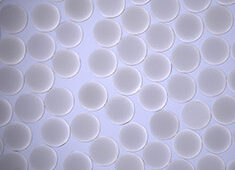This cartridge case shows the three distinct marks, or ‘signatures,’ impressed on its surface when it was fired by a gun: the firing pin impression (FP), the breech face impression (BF) and the ejector mark (EM). NIST’s standard casing ensures that forensic labs can accurately match signatures on shells found at crime scenes with images in a national database. |
Thanks
to a new reference standard developed by the National Institute of
Standards and Technology (NIST), law enforcement agencies will have an
easier time linking the nearly 200,000 cartridge cases recovered
annually at U.S. crime scenes to specific firearms.
Cartridge
cases—the empty shells left behind after a gun is fired—are routinely
sent to forensic laboratories for analysis when they’re found at a
shooting scene. Using a specialized microscope called an Integrated
Ballistic Identification System (IBIS), lab technicians acquire digital
images of three markings, or “signatures,” impressed on the cartridge
case by the gun that fired it. These signatures—the firing pin
impression, the breech face impression and the ejector mark—are unique
when fired from a specific firearm and can serve as “fingerprints” for
that gun once the digital images are entered into a national database
known as the National Integrated Ballistic Information Network (NIBIN).
For
forensic examiners to reliably match recovered cartridge cases with
ones whose signatures have been recorded in the NIBIN, they need to have
confidence in the accuracy of the equipment and procedures used to make
the link. That’s where NIST’s new “standard casing” comes in. The
standard contains two items: an exact replica of a master cartridge case
with distinct signature marks (obtained from the Department of
Justice’s Bureau of Alcohol, Tobacco, Firearms and Explosives, or ATF),
and a “golden” digital image of those same signatures that reside on the
NIBIN.
Forensic
labs can image the signatures on the SRM cartridge cases—a test of
their optical microscope and measurement procedures—and compare those
images to the golden image provided by ATF. In this way, lab technicians
can verify their equipment is calibrated and functioning properly,
validate their methodology, and can demonstrate that their work is
traceable to an authoritative national standard.
To
make the standard cartridge cases, NIST engineers used a technique
called electroforming, which is similar to the electroplating method
used by jewelers to coat objects with silver, gold and other metals.
First, a master fired cartridge case was selected. Then the
electroforming process created a near-perfect inverse copy, like a
photographic negative, of the master. The negative was then used as a
mold from which multiple replicas were made.
“The
electroforming process is so accurate that the replica cartridge cases
made using it have signature marks that are less than a few
micrometers—millionths of a meter—different from those on the master,”
says NIST mechanical engineer Alan Zheng, one of the team members who
developed the reference casing.
NIST
Standard Reference Material (SRM) 2461, Standard Casing, is the second
NIST ballistic reference material to be made available to law
enforcement agencies. In 2006, NIST created a Standard Bullet, SRM 2460,
which is machined to precisely mimic the firing markings seen on sample
bullets obtained from ATF and the Federal Bureau of Investigation
(FBI). Like the standard cartridge case, SRM 2460 includes a bullet and
golden images of the striations on the bullet.*
“Together,
the two SRMs make a powerful tool for forensic labs and the law
enforcers they support,” says NIST physical science technician Brian
Renegar, another member of the ballistics SRM development team. “For
instance, if a crime is committed in California, and another in New York
using the same firearm, the link between the two crimes might be
missed. The NIBIN network enables forensic examiners to identify these
potential matches, or ‘hits’, where they might otherwise go unnoticed.
And the NIST ballistic SRMs ensure that the imaging systems used in the
labs are calibrated and operating properly, and that proper measurement
procedures are being followed.”
For more information, including ordering instructions, for both SRM 2460 and 2461, go to www.nist.gov/srm/index.cfm.





